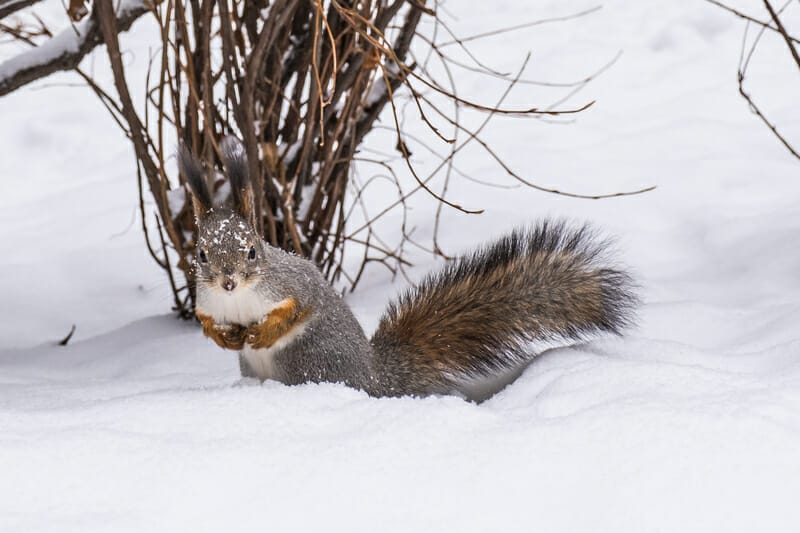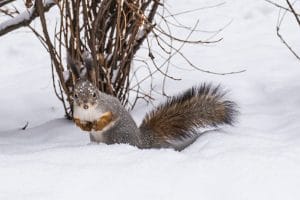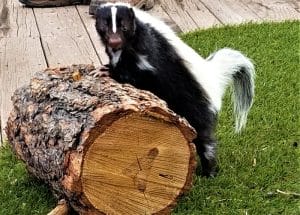We’ve had a warm fall in Southern Ontario so far, but we all know from experience how quickly that can change. While you’re running the A/C and putting off closing the pool or cottage, animals like raccoons, skunks, and mice are anticipating a winter blast and looking for a nice secure home to ride it out (and have some babies while they’re at it).
As you get ready to winterize your home, it’s important to note that unwanted furry guests seeking shelter can become a major headache. Wildlife intrusion poses risks to your home, health, and even the animals themselves. The best way to deal with it is to make sure they don’t get into your house to begin with.
At Bad Company Wildlife Eviction, our business revolves around local wildlife eviction, but trust us- we’re all for it if you take active steps to keep wildlife out of your home this winter. In this blog, we show you how to identify, seal, and prevent entry points for wildlife, ensuring a cozy, critter-free winter season in 2024.
Identifying Entry Points
Understanding where wildlife typically gains access to your home is a pivotal step in keeping them at bay during the winter months. These common entry points serve as gateways for animals seeking shelter and warmth:
- Attics and Crawl Spaces: These hidden spaces are magnets for wildlife, offering a cozy refuge from the cold. Squirrels, raccoons, bats, and birds often find their way into attics and crawl spaces through small openings.
- Gaps in Siding and Roofing: Loose or damaged siding and roofing materials create vulnerable spots that wildlife can exploit. These areas may provide easy access to critters like squirrels, raccoons, or birds.
- Vents and Chimneys: Unprotected vents and chimneys can act as inviting entry points for birds, bats, and even smaller mammals like squirrels or raccoons. Without proper safeguards, these openings can become critter pathways.
- Cracks in the Foundation: A damaged foundation, including cracks or gaps, can create opportunities for animals to enter your home. This is a common entry point for rodents like mice or rats.
Tips for Spotting Wildlife Entry Points
Once you’re aware of the common entry points that wildlife can exploit, the next crucial step is to spot these openings in and around your property actively. Here are some tips to help you pinpoint any problem spaces and keep wildlife out of your home.
- Visual Inspections: Scan the exterior of your home for any visible openings, cracks, or gaps. Pay special attention to areas surrounding windows, doors, vents, and chimneys. It would be best if you also looked for damaged or deteriorating materials, such as worn-out weather stripping or loose siding.
- Listening for Unusual Sounds: Sometimes, you can hear evidence of wildlife presence before you see it. Be attuned to unusual sounds such as scratching, scurrying, or rustling noises within your walls or attic, as these may indicate critter activity.
- Monitoring for Signs of Activity: Check attics, crawl spaces, and other potential entry points for droppings, tracks, or nests. These telltale signs can provide valuable clues regarding the presence of unwelcome houseguests. Another surefire sign that you have visitors is a urine odour- that’s the worst.
By following these tips and being diligent, you can spot potential entry points and take action to keep wildlife out of your home.
Sealing Entry Points
If you’ve noticed potential entry points but no one seems to have moved in yet, it’s important to move quickly. Delaying repairs can inadvertently extend an open invitation to more curious critters.
Start by gathering the necessary tools and materials. Depending on the issue, you’ll need items such as caulking, weather stripping, wire mesh, insulation, chimney caps, and vent covers. Having these materials on hand will streamline the sealing process.
Effective sealing involves a series of carefully executed steps:
- Repairing Damaged Areas: Fix any damaged materials, such as torn screens or loose siding. Ensure that the entry point is in good condition before proceeding with sealing.
- Sealing Gaps and Cracks: Use high-quality caulk and weather stripping to seal gaps around windows, doors, vents, and chimneys. These areas are common entry points for wildlife. For larger openings, especially in attics or crawl spaces, install wire mesh to block access.
- Installing Protective Barriers: Chimney caps and vent covers are essential protective barriers that prevent animals from entering through these openings. Ensure that these are securely in place and made from durable materials.
Safety should always be a priority during the sealing process. When working at heights or in confined spaces like attics or crawl spaces, exercise caution and use the appropriate safety equipment, including helmets, gloves, and knee pads. If the task feels beyond your capabilities, consider seeking professional assistance.
Hiring Professionals for Local Wildlife Evictionany Wildlife Eviction.
If you suspect that wildlife has already gained access to your property, you want to tread carefully. While sealing entry points is a vital step in preventing future intrusions, it’s equally important to address any existing wildlife presence with care and compassion. Attempting DIY sealing without professional guidance can lead to unintended consequences, particularly the separation of mothers from their babies, resulting in tragic outcomes.
At Bad Company Wildlife Eviction, our approach to wildlife removal and prevention is guided by a deep love and respect for animals. Our clients choose us because they want the job done right and, more importantly, done humanely. It’s a win-win situation—no animals are harmed, and homeowners can enjoy peace of mind knowing they’re not sharing their roof with raccoons, bats, or other critters any longer.
Keep Wildlife Out of Your Home With Some Extra Help!
By contacting Bad Company Wildlife Eviction, you ensure that both your home and the animals are treated with the care and respect they deserve. Our experts will assess the situation, implement humane removal strategies, and ensure that any separated families are safely reunited. It’s not just about keeping critters out; it’s about ensuring the welfare of all involved parties—homeowners and wildlife alike. To learn more or schedule an estimate for local wildlife eviction, contact us today at 1-855-937-0418.



